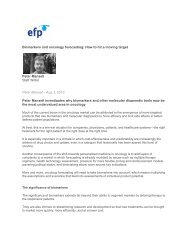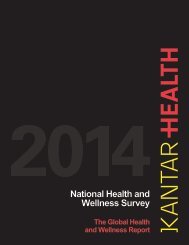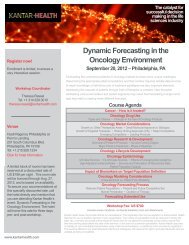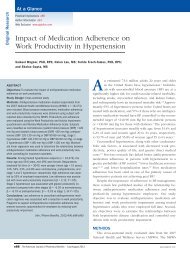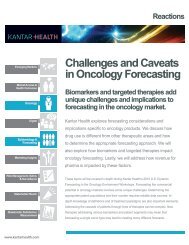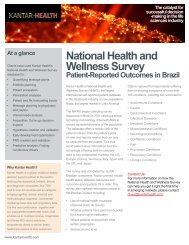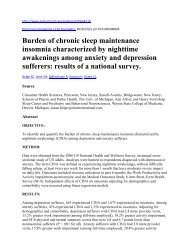Navigating the tense, complex oncology market - Kantar Health
Navigating the tense, complex oncology market - Kantar Health
Navigating the tense, complex oncology market - Kantar Health
You also want an ePaper? Increase the reach of your titles
YUMPU automatically turns print PDFs into web optimized ePapers that Google loves.
Brand Marketing &<br />
Communications<br />
<strong>Navigating</strong> <strong>the</strong> <strong>tense</strong>, <strong>complex</strong> <strong>oncology</strong> <strong>market</strong><br />
and GPOs provide an increasingly broad range of services,<br />
including advanced clinical support to patients, support with<br />
side effect management, improved compliance support, and<br />
administrative assistance in gaining insurance coverage or<br />
identifying additional financial assistance for patients (such<br />
as drug-company-sponsored patient assistance programs for<br />
those who need it).<br />
However, under <strong>the</strong> buy-and-bill model, “oncologists face<br />
increased risk that <strong>the</strong>y will have administered a high-cost<br />
<strong>the</strong>rapy only to find that <strong>the</strong>ir charge is denied payment or<br />
payment is significantly delayed, and a growing number of<br />
patients are unable to afford <strong>the</strong>ir portion of <strong>the</strong> bill,” says<br />
Warner of <strong>Kantar</strong> <strong>Health</strong>.<br />
In 2005, CMS implemented significant changes in <strong>the</strong><br />
way it pays oncologists for physician-administered drugs<br />
and related services—changes that continue to influence<br />
<strong>the</strong> landscape in <strong>oncology</strong> today. At that time, Medicare<br />
changed its policies to set payments for covered drugs at <strong>the</strong><br />
Average Sales Price (ASP) rate plus 6%, which is based on<br />
actual transaction prices and, basically, less than <strong>the</strong> previous<br />
setpoint, Average Wholesale Price (AWP). “Prior to 2005, it<br />
was not uncommon for oncologists to make more than 50%<br />
markup on a class of drugs that was already growing at 25%<br />
per year, so when patients were not able to pay <strong>the</strong>ir co-pays,<br />
it didn’t really matter,” says OncoMed’s Zweigenhaft. “The<br />
earlier CMS rules, which allowed for huge margins, set up a<br />
whole set of perverse economics, ra<strong>the</strong>r than economics based<br />
on sound outcomes data,” says Zweigenhaft. “Cancer is still<br />
not managed that way—but it should be.”<br />
With current reimbursement rates dramatically reduced,<br />
many physicians would be forced to operate at a loss if <strong>the</strong>y<br />
were unable to collect <strong>the</strong> patients’ co-payment. “In certain<br />
situations, it is becoming increasingly common for patients<br />
to be referred to <strong>the</strong> hospital out-patient setting, so that <strong>the</strong>ir<br />
anti-cancer medications can be billed through <strong>the</strong> oftenmore-generous<br />
medication benefit, ra<strong>the</strong>r than <strong>the</strong> pharmacy<br />
benefit, portion of <strong>the</strong>ir coverage, due to <strong>the</strong>se financial<br />
dynamics,” says Warner of <strong>Kantar</strong> <strong>Health</strong>.<br />
In an effort to eliminate some of <strong>the</strong> financial incentives<br />
tied to drug administration in <strong>the</strong> buy-and-bill model, some<br />
payer plans now require that oncologists order <strong>the</strong>ir infused<br />
drugs on a patient-by-patient basis from a specific specialty<br />
pharmacy. The pharmacy delivers <strong>the</strong> drugs to <strong>the</strong> practice<br />
at <strong>the</strong> time <strong>the</strong> patient has <strong>the</strong>ir infusion visit. “In this newer<br />
model, <strong>the</strong> payer pays <strong>the</strong> specialty pharmacy directly for <strong>the</strong><br />
drugs and <strong>the</strong> physician only bills <strong>the</strong> drug administration<br />
fee,” explains Warner of <strong>Kantar</strong> <strong>Health</strong>. “While this eliminates<br />
<strong>the</strong> profit incentive, this model can result in significant<br />
drug waste if <strong>the</strong> patient is not able to receive <strong>the</strong>ir intended<br />
chemo<strong>the</strong>rapy because <strong>the</strong> drugs cannot be returned or used<br />
for a different patient.”<br />
Not surprisingly, it is also “very unpopular” with<br />
oncologists, Warner adds. “The greatest advantage of <strong>the</strong><br />
traditional buy-and-bill model is that a large inventory is<br />
maintained at <strong>the</strong> oncologists’ practice setting, so physicians<br />
are able to tailor <strong>the</strong> exact dose and combination of drugs to<br />
patients as <strong>the</strong>y arrive for <strong>the</strong>ir visit.”<br />
Altos Solutions, a Los Altos, CA-based IT and <strong>oncology</strong><br />
consulting company, performs a National Oncology Practice<br />
Benchmark annually. In its 2011 Benchmark (published<br />
in <strong>the</strong> November issue of J. of Oncology Practice, an ASCO<br />
publication), it reports that drug revenue as a percentage<br />
of total practice revenue has declined from 85% in 2005 to<br />
about 66% in 2010, and that <strong>the</strong> drug margin (i.e., profit) has<br />
declined from 22% to 9% (as a percentage of total revenue)<br />
over <strong>the</strong> same period. Although drug margin is clearly not <strong>the</strong><br />
only source of revenue for community <strong>oncology</strong> practices, it<br />
has been an important one. In a previous report (published<br />
in <strong>the</strong> September J. of Oncology Practice), <strong>the</strong> Altos authors<br />
conclude:<br />
“As <strong>the</strong> economic model for community practice<br />
transitions from one that relied on <strong>the</strong> profit margin from<br />
drugs, <strong>the</strong> question becomes what is <strong>the</strong> next economic<br />
model? … Clearly, appropriate use of [new diagnostics and<br />
sophisticated tumor typing] will demand more physician<br />
time, not less. … Although <strong>the</strong> benefits of new diagnostic<br />
and treatment tools are desired by everyone involved in<br />
cancer care—patients, providers and payers—<strong>the</strong>y cannot<br />
be delivered in <strong>the</strong> existing community <strong>oncology</strong> economic<br />
business model.”<br />
Off-label drug use in <strong>oncology</strong><br />
Given <strong>the</strong> limited number of <strong>oncology</strong> agents available and<br />
<strong>the</strong> many types of cancers that are encountered, <strong>the</strong> off-label<br />
use of medications in cancer treatment has been widespread<br />
for decades. Today, estimates show that more than half of all<br />
uses of cancer-treating drugs are prescribed off-label, notes<br />
Brown of Xcenda.<br />
While having more options to choose from may offer an<br />
ongoing ray of hope for oncologists and patients who are<br />
running out of treatment options, “<strong>the</strong> quality of clinical<br />
evidence to support off-label use for a given patient may be<br />
weak, <strong>the</strong>reby exposing patients to ineffective and potentially<br />
toxic <strong>the</strong>rapy, and creating unnecessary expenses for payers,”<br />
says Harish Dave, MD, MBA, VP of <strong>the</strong> Oncology Therapeutic<br />
Delivery Unit of Quintiles (Rockville, MD). As a result, to<br />
curtail healthcare costs, payers are actively working to curtail<br />
off-label prescribing in <strong>oncology</strong>.<br />
Today, <strong>the</strong> majority of cancer patients—roughly 60%—are<br />
on Medicare. When it comes to Medicare, coverage of offlabel<br />
drug use in <strong>oncology</strong> is limited to those agents that are<br />
listed in at least one of four accepted compendia:<br />
• American Hospital Formulary Service Drug Information<br />
• Gold Standard Inc. Clinical Pharmacology Compendium<br />
• National Comprehensive Cancer Network (NCCN)<br />
Drugs and Biologics Compendium<br />
• Thomson Micromedex DrugDex Compendium<br />
“Today, most private payers follow Medicare coverage<br />
policy when setting <strong>the</strong>ir own criteria. Thus, payers are<br />
increasingly refusing to pay for treatments off-label, unless<br />
<strong>the</strong>y have a compendia listing or sufficient evidence to support<br />
<strong>the</strong>ir clinical value,” says Warner of <strong>Kantar</strong> <strong>Health</strong>. “For this<br />
reason, it’s in <strong>the</strong> drug company’s best interest to actively<br />
pursue a solid compendia strategy.”<br />
Oral meds and self-injectables<br />
Yet ano<strong>the</strong>r <strong>complex</strong>ity of oncolytics is that <strong>the</strong> form of<br />
drug delivery can affect its affordability, patient acceptance<br />
and, indirectly, its efficacy. Traditionally, chemo<strong>the</strong>rapy has<br />
been administered via intravenous infusion, but over <strong>the</strong> past<br />
decade, <strong>the</strong>re has been a surge of newer oral and self-injected<br />
agents. Some are traditional chemo<strong>the</strong>rapies, such as Xeloda<br />
(capecitabine), while o<strong>the</strong>rs are targeted <strong>the</strong>rapies, such as<br />
Gleevec (imatinib) and Sutent (sunitinib). Today, of <strong>the</strong> 125<br />
drugs in Phase III clinical development for cancer, 38 are oral<br />
medications, according to Medco.<br />
For drug developers, <strong>the</strong> decision about whe<strong>the</strong>r<br />
to pursue <strong>the</strong> development of a compound as an oral or<br />
injectable <strong>the</strong>rapy will be dictated by clinical and commercial<br />
considerations. If <strong>the</strong> drug’s side effect profile supports selfadministration,<br />
<strong>the</strong>re are some key benefits for <strong>the</strong> right<br />
patients, says Koerner of ION Solutions. These include <strong>the</strong><br />
freedom for patients to take <strong>the</strong>ir medications at home (saving<br />
time and travel), and in some instances, increased insurance<br />
coverage, as <strong>the</strong> pharmacy benefit may be preferential to <strong>the</strong><br />
medical benefit in terms of patient co-pays and administrative<br />
requirements for oral <strong>oncology</strong> medications.<br />
Meanwhile, <strong>the</strong> pursuit of self-injectable <strong>oncology</strong> meds<br />
is also garnering attention. For instance, Roche is currently<br />
developing subcutaneous reformulations of Herceptin and<br />
Rituxan (rituximab). The potential benefit for <strong>the</strong> patient<br />
would be shorter medical visits, as <strong>the</strong> subcutaneous injection<br />
(ra<strong>the</strong>r than <strong>the</strong> IV infusion) can be given in a few minutes<br />
ra<strong>the</strong>r than hours, or possibly at-home administration. “This<br />
is particularly attractive for <strong>the</strong>se two agents when <strong>the</strong>y are<br />
used in <strong>the</strong> adjuvant/maintenance settings with treatment<br />
lasting for more than a year,” says Kate Keeping, principal<br />
analyst at Decision Resources, a <strong>market</strong> research company.<br />
“From a commercial perspective, this also offers Roche <strong>the</strong><br />
opportunity to offset <strong>the</strong> imminent threat of biosimilar<br />
competition to <strong>the</strong> intravenous formulations of <strong>the</strong>se brands.”<br />
A subcutaneous formulation of Velcade (bortezomib;<br />
Millennium Pharmaceuticals) for multiple myeloma was<br />
recently launched, which not only offers more convenient<br />
delivery, but also reduced neurotoxicity, she says.<br />
There are drawbacks to self-administration: <strong>the</strong> risk of<br />
adherence and compliance issues, and failure to use <strong>the</strong><br />
<strong>the</strong>rapy as prescribed (in particular, missing doses) that can<br />
impact outcomes and result in premature emergence of<br />
drug resistance. And at-home administration reduces patient<br />
interaction with both physicians and nurses, which reduces<br />
opportunities for regular monitoring. US physicians, who<br />
receive a fee for administering intravenous drugs, may also<br />
resist <strong>the</strong> loss of that revenue stream.<br />
National studies confirm that overall noncompliance to<br />
oral drugs across all disease categories can run as high as 50%<br />
to 70%. “This presents a challenge in any disease state but can<br />
have a significant impact when it comes to chemo<strong>the</strong>rapy,”<br />
says Koerner of ION Solutions. “In some instances, patients<br />
may have side effects or cost pressures, and decide not to<br />
take <strong>the</strong> drug or take <strong>the</strong> drug less frequently,” says Brown of<br />
Xcenda. “In o<strong>the</strong>rs, <strong>the</strong> physician may opt to dose-reduce <strong>the</strong><br />
patient to manage through certain side effects, but <strong>the</strong> patient<br />
may want to take <strong>the</strong> full dose to ensure <strong>the</strong>y are getting <strong>the</strong><br />
maximum benefit of <strong>the</strong> drug.” With many of <strong>the</strong>se drugs<br />
costing as much as $7,500 a month, says Quigley of IMS,<br />
it serves nobody’s interest to have <strong>the</strong>m be administered<br />
incorrectly or not at all.”<br />
As for distribution, oral <strong>oncology</strong> <strong>the</strong>rapies often fall<br />
outside <strong>the</strong> traditional buy-and-bill model. In this realm,<br />
“Specialty pharmacy providers are taking on a much greater<br />
role in patient management, as office-based clinicians turn<br />
over <strong>the</strong> ongoing management for self-administered products<br />
to <strong>the</strong>m,” says Doug Neely of Xcenda. “Payers are much more<br />
comfortable managing drugs through traditional pharmacy<br />
benefit management (PBM) systems.”<br />
“With <strong>the</strong> growing availability of oral options for <strong>oncology</strong><br />
treatment, some larger <strong>oncology</strong> practices have opened<br />
dispensing pharmacies, so <strong>the</strong>y can also dispense oral cancer<br />
drugs to patients,” says Warner of <strong>Kantar</strong> <strong>Health</strong>. However,<br />
this approach can bring significant business challenges<br />
for <strong>oncology</strong> practices, so it tends to be seen only in larger<br />
<strong>oncology</strong> practices. It is thought that less than 10% of practices<br />
currently dispense oral <strong>oncology</strong> drugs directly. “In <strong>oncology</strong>,<br />
payers in turn will continue to scrutinize <strong>the</strong> incremental value<br />
of new <strong>the</strong>rapies, while experimenting with new approaches<br />
to manage overall costs, while maintaining access to quality<br />
cancer care,” she concludes. “Manufacturers need to evolve<br />
<strong>the</strong>ir clinical development, <strong>market</strong>ing and sales strategies in<br />
order to remain competitive in this <strong>complex</strong> arena.”<br />
Visit our new website at www.PharmaceuticalCommerce.com May | June 2012



